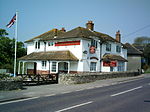Winterborne St Martin

Winterborne St Martin, commonly known as Martinstown, is a village and civil parish in southwest Dorset, England, situated 4 miles (6.4 km) southwest of Dorchester, beside Maiden Castle. In 2013 the estimated population of the civil parish was 780. In the centre of the village is the parish church of St Martin, which dates from the 12th century and has a Norman font. Other amenities in the village include a public house, village hall and post office. Bronze Age barrows including Clandon Barrow surround the village, and Maiden Castle hillfort is nearby. The stream running through the village is a winterbourne though rarely dries out in the summer now. Winterborne St Martin is in the UK Weather Records for the Highest 24-hour total rainfall, which was recorded in the village on 18 July 1955. The total recorded was 279 mm (11 inches) in a 15-hour period. However this record was surpassed by Seathwaite in Cumbria in 2009.
Excerpt from the Wikipedia article Winterborne St Martin (License: CC BY-SA 3.0, Authors, Images).Winterborne St Martin
Burnside,
Geographical coordinates (GPS) Address Nearby Places Show on map
Geographical coordinates (GPS)
| Latitude | Longitude |
|---|---|
| N 50.6992 ° | E -2.5009 ° |
Address
Burnside
Burnside
DT2 9JY , Winterborne St. Martin
England, United Kingdom
Open on Google Maps









